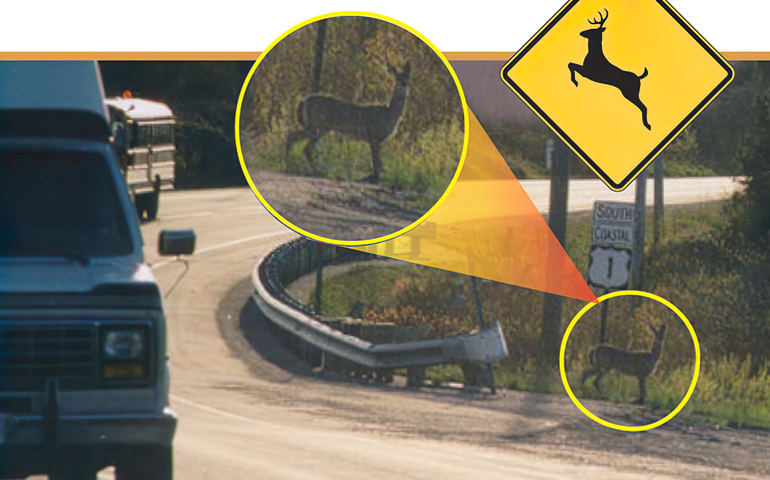Maine ranks as high risk, and 22nd nationwide, in animal collision study
 Courtesy / Maine Department of Transportation
The state has an active campaign warning motorists about animal collisions. State Farm ranked Maine 22nd nationwide for risk of collision.
Courtesy / Maine Department of Transportation
The state has an active campaign warning motorists about animal collisions. State Farm ranked Maine 22nd nationwide for risk of collision.
Maine drivers have a 1-in-91 chance of colliding with an animal while driving, ranking them 22nd in the nation and at high risk for critter collisions, according to a State Farm insurance study released Wednesday.
According to the Maine Department of Transportation, such accidents cost the state's drivers and insurance companies about $893,000 a year in injuries and damages.
State Farm had 1,365 auto claims for Maine animal collisions in 2019; the study includes all animals, from moose to farm animals to dogs to rodents. State Farm rates a state at high risk if there is at least a 1-in-100 chance of colliding with an animal while driving.
Overall, the state Department of Transportation recorded nearly 6,467 animal collisions in 2018, the last year for which statistics were available. So far, there have been 3,292 recorded by the state.
Overall in the U.S., 1 in 116 drivers will collide with an animal over the course of a year. Most animal-related crashes across the country occur from October to December, according to State Farm, with most collisions — 67% — with deer. That's the case in Maine, too, with deer involved in 5,292 of the 2018 accidents.
In Maine, deer crashes accounted for 92.7% of animal collissions between 2014-28, a whopping 25,643 accidents out of 27,300 reported collisions over that five-year period, compared to 1,484 with moose, 141 with bears, 203 with turkers and 829 with other animals,
The State Farm study found that since the COVID-19 pandemic started in March, there was a 20% decrease (more than 70,000 claims) in animal collisions because of fewer drivers being on the road.
In Maine, traffic volume dropped by 50% at the beginning of the pandemic, state DOT officials said. Current statewide vehicle-miles traveled levels are still down between 5% and 10% of what they were at this time last year.
"We have not looked at wildlife crashes during the COVID period specifically," Bob Skehan, director of safety for the Maine DOT, told Mainebiz. "Although crash data can vary significantly from year to year, I think it would be safe to say we’re slightly down from the previous two years. This is quite likely due to decreased traffic volumes statewide during the COVID period, but not a certainty."
The state has an active campaign to alert drivers to animal crashes, and stresses November is "deer collision month," as the animals travel more, looking to breed.
Some of the statistics from the State Farm study:
- There were 43,219 collisions with birds last year; 15,000 of those with turkeys;
- There were 1.55 million collisions with deer nationwide in 2019;
- Farm animals accounted for 33,007 collisions (includes pig, hog, cow, goat, sheep, horse, donkey);
- Pets (dogs and cats) combined for a total of 102,051 collisions nationwide:
- There were 21,000-plus State Farm claims involving large wild animals (bears, elk, moose, caribou, ox, antelope, wild boar).
- Safety belts saved an estimated 114,955 lives nationwide in 2017.
The top 10 risk states, in order of risk, were West Virginia, Montana, Pennsylvania, South Dakota, Michigan, Wisconsin, Iowa, Mississippi, Minnesota and Wyoming.
Both the state of Maine and State Farm say that collisions with animals can be avoided if drivers use extra caution and slow down in known animal crossing zones and use high beams when appropriate.










0 Comments